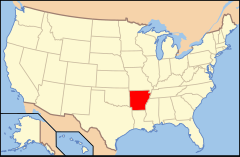| Fayetteville Shale | |
|---|---|
| Stratigraphic range: Carboniferous: Mississippian (Serpukhovian)[1] | |
 Outcrop of the lower Fayetteville Shale in northern Arkansas | |
| Type | Geological formation |
| Sub-units | Wedington Sandstone Member |
| Underlies | Pitkin Limestone,[2] Hale Formation[3] |
| Overlies | Ruddell Shale, Batesville Sandstone[2] Moorefield Shale[3] |
| Area | Arkansas and Oklahoma[4] |
| Thickness | 50 to 500 feet (15 to 152 m) |
| Lithology | |
| Primary | Shale |
| Other | Sandstone, limestone |
| Location | |
| Region | Arkansas |
| Country | |
| Extent | 50 miles (80 km) |
| Type section | |
| Named for | Fayetteville, Washington County, Arkansas |
| Named by | Frederick Willard Simonds[5][6] |
 The Fayetteville formation runs widespread across Arkansas | |
Wikimedia Commons has media related to Fayetteville Shale.
The Fayetteville Shale is a geologic formation of Mississippian age (354–323 million years ago) composed of tight shale within the Arkoma Basin of Arkansas and Oklahoma.[4][7] It is named for the city of Fayetteville, Arkansas, and requires hydraulic fracturing to release the natural gas contained within.
- ^ Cite error: The named reference
gordonwas invoked but never defined (see the help page). - ^ a b Freemen, T. Fossils of Arkansas. Arkansas Geologic Commission.
- ^ a b "Major Stratigraphic Layers of the Fayetteville Shale Formation". Chesapeake Energy, Inc. Archived from the original on August 20, 2011. Retrieved July 25, 2011.
- ^ a b Cite error: The named reference
Sandowas invoked but never defined (see the help page). - ^ Branner, J. (1891). "Introduction". Arkansas Geological Survey Annual Report 1888. 4: xiii.
- ^ Simonds, F.W. (1891). "The geology of Washington County". Arkansas Geological Survey Annual Report 1888. 4: 26, 42–49.
- ^ Reed, Michael (June 2013). "Shale Play Should See Added Capacity Next 2 Years". Pipeline & Gas Journal. 240 (6). Houston, TX: Oildom Publishing Company: 46.